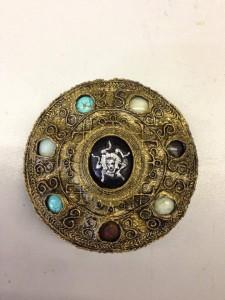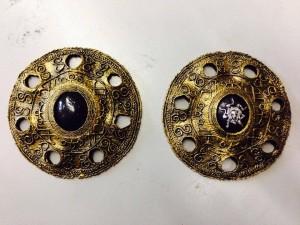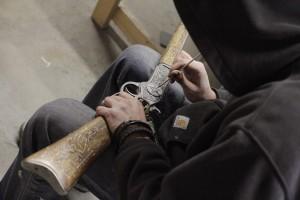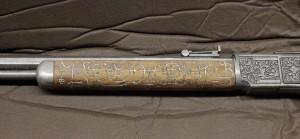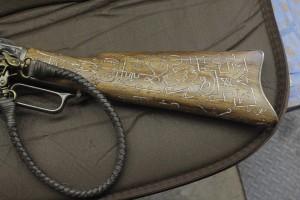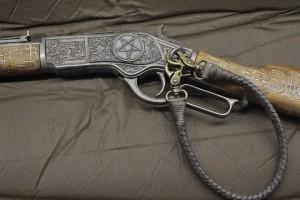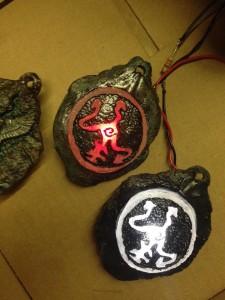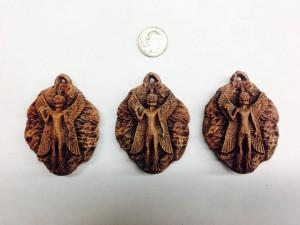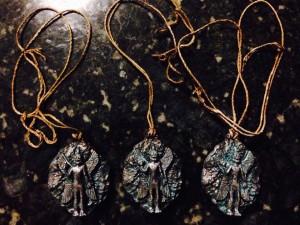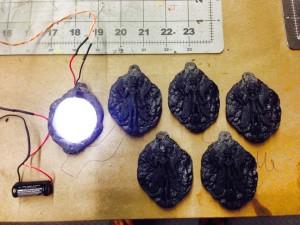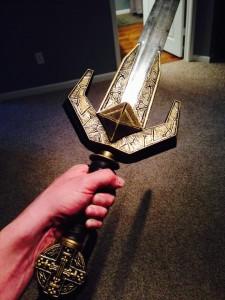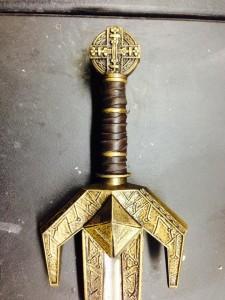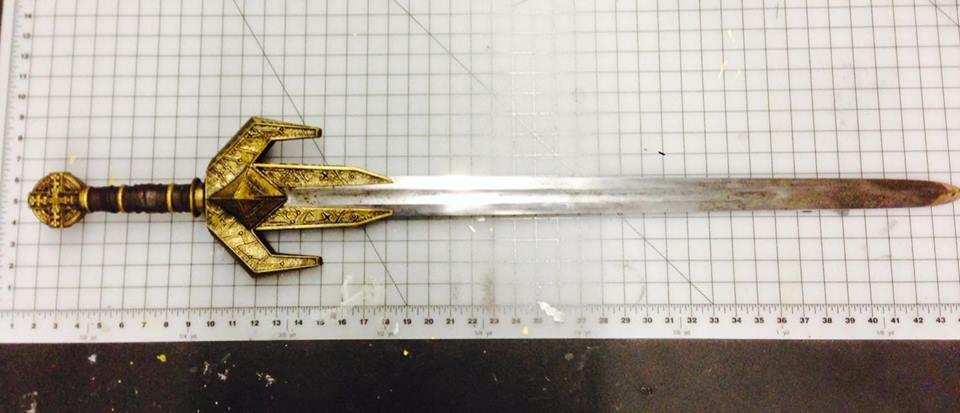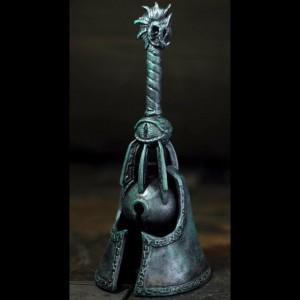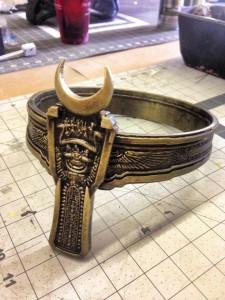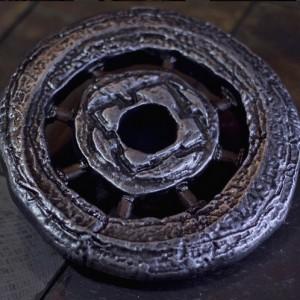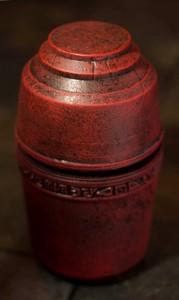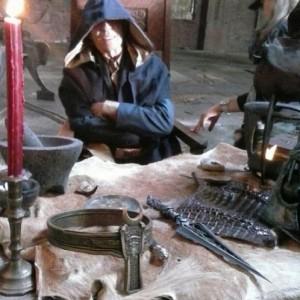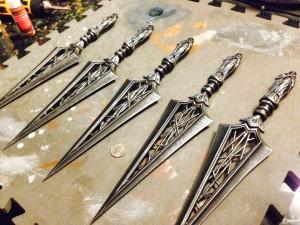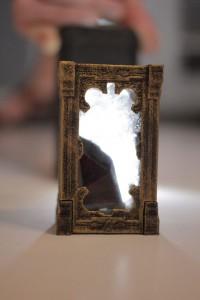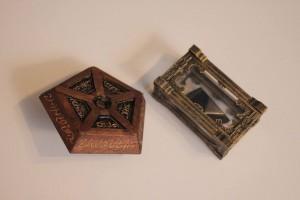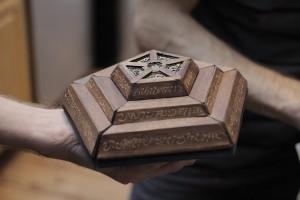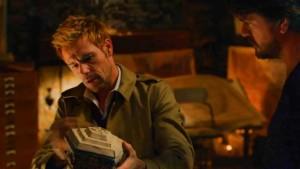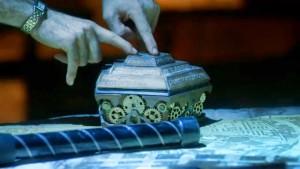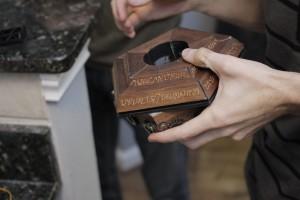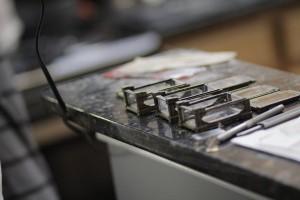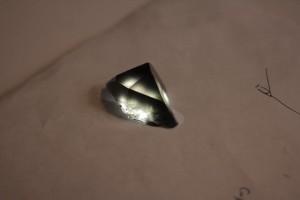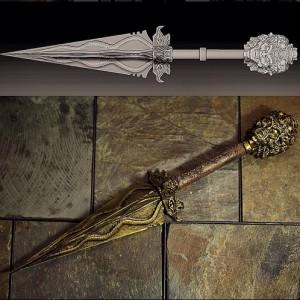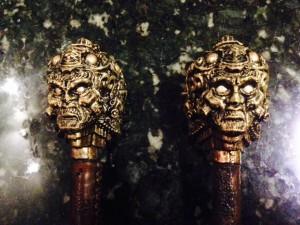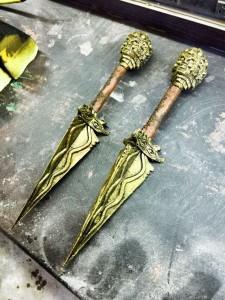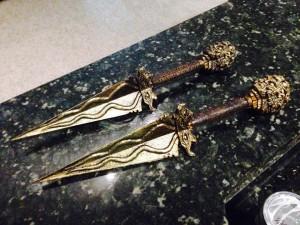3DPrint EXCLUSIVE: Behind the Scenes Look at NBC Show, Constantine’s 3D Printed Props & How a Team of ‘Misfits’ Succeeded
For those of you who have watched the TV show Constantine, you know just how addicting and thrilling the drama was this past season. The 13 episode season recently ended in February, with fans of the series hoping and praying that there is a Season 2. It is expected that NBC will officially decide whether or not Season 2 of the show will take place or not, sometime this month.
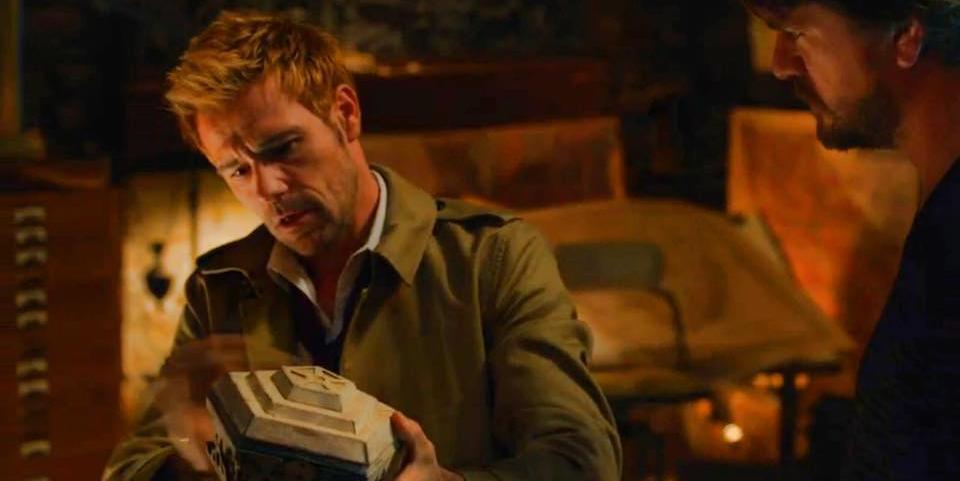 For anyone who watched most of, or all of the season, you probably noticed the many props that went into the production of the show. What most of you don’t realize, however, is the fact that many of these props were actually 3D printed.
For anyone who watched most of, or all of the season, you probably noticed the many props that went into the production of the show. What most of you don’t realize, however, is the fact that many of these props were actually 3D printed.
For 3D designer, Adil Muschelewicz, and his incredible team at Hex Mortis, they were tasked with designing and 3D printing many of the props that were used on the critically acclaimed TV show. Muschelewicz was kind enough to take the time to sit down and answer some questions that we had for him. He outlines the story behind how he got the job, many of the rather humorous scenarios that played out in the production of they props, and how a team of “misfit artists” came together for something quite phenomenal. The interview can be found below (with minor edits).
3DPrint: Tell us a little bit about yourself and your company.
Adil: My Name is Adil “IAMSCUMBAG” Muschelewicz and this year I’m starting The GeminiMind with my colleagues Traivs Wood and Troy Harding. For the past 2 years, we have been building a rapid prototyping company that deals with design and engineering of both 2-dimensional and 3-dimensional prototypes, products and props. We’ve spent the past year freelancing and subcontracting with companies like Hex Mortis, Volpin Props, GSTQ Fashions and Black Tie FX to bring 2-dimensional concept art to 3-dimensional life within the craziest of time constraints. To accomplish this, We use various forms of 3D printing and rapid prototyping. I worked at Clemson University and have a background in 2-dimensional design, so naturally the jump from 2D concept to 3D made sense. At Clemson, I “dabbled” in a lot of NDA prototype projects and helped a group of students fabricate a toy from start to finish. It took a class of 20 students 3 weeks to make one awesomely packaged bobble head.
3DPrint: How did the contract with Constantine come about? How were you fortunate enough to get the job?
Adil: Over a year ago, Troy and I met Josh Cole, Owner of Hex Mortis, at a convention. He was wearing a Dr. Doom costume and it was extremely well made. Something about the way he wore the costume just blew my mind. The foam work read to me as metal and when I realized it, I was just in awe. We had met with him later on ,after making a test Iron Man helmet by slicing it up into pieces and printing those pieces across multiple prints. Hex, in turn, saw the helmet when we brought it to their shop in Georgia. He immediately saw the potential and wanted more out of us.
From there we perfected our process. After fabricating a few helmets with Hex, it became apparent that in terms of job titles, Hex was mostly in charge of art direction. I also took lead on art direction from time to time as well, but was mostly responsible for 3D modeling and planning the prints. Troy was running the printers, and as a power-team, with the Help of Mike Kaufman and Devan Henderson, we would do hours of body work to perfect these props. One day a Prop Master contacted Hex and asked (paraphrased), “I heard about you guys. I got a project and it’s kind of a big deal.”
He then showed us this “Scry Medallion” concept, and a gun called the ‘Ace of Winchesters’ for a TV show called “Constantine”. The only problem was that they needed these props “yesterday”. So Without hesitation, I replied, “We will do it!”
- Scry Medallion
- Scry Medallion
- Scry Medallion
- Scry Medallion
Hex took a MASSIVE chance on us. but what were we gonna do? Say NO? I had worked with near impossible deadlines before and I was confident that I could model that medallion in no time! I was confident Troy could have it printed with zero warping and Hex could master it. We ordered some pizza, threw on some video games, and I had the medallion modeled in no tie. Then Troy printed it out, and it was in-hand the next morning. The Medallion was a stunt prop too, so we had to include magnetic spheres on the inside of it and paint them to look like gems.
The Ace of Winchesters was a modified rifle that we 3D printed a few accent pieces for. For designs on the bottom of the rifle, I vectored the concept patterns and we ran that over to a local sign shop to cut a pattern for us. Hex then took a Dremel to etch onto the gun, the angelic runes, and then did all of the color matching.
- Ace of Winchesters
- Ace of Winchesters
- Ace of Winchesters
- Ace of Winchesters
We were simply given a test and we did our best as a team. We pulled together to just get it done. The next day, Hex sent the higher-ups a video of the medallion and how it worked. The prop-master was super happy, and asked if he could pick it up and show it to the director. It wasn’t even sanded or painted. Luckily because it was 3D printed, we were able to make quick changes to the prop and this bought Hex a few days to deliver on the gun. The next time the prop-master came to the shop he immediately started telling us about the next props he might need our help on. Hex gave him a card and that was the start of an insanely chaotic run.
3DPrint: Are you a viewer of Constantine TV show? Have your props made an appearance on the show?
Adil: Out of the 13 episodes, we ABSOLUTELY watched them all. I’d say 11 episodes featured props from Hex Mortis. We were designing Hero and Easter Egg props. These were props that range from characters using these magical items and the occasional “blink or you’ll miss it” Easter egg. Some of the props were from concept art that came from HQ and others we got a chance to design ourselves. We tried to give the team members chances to shine, so for example, “Faust’s Crown” was designed and rendered by myself, whereas the 3 items on Faust’s Desk were drawn by Hex, and tweaked as a team.
3DPrint: How many different props did you make for the show and how many were 3D printed?
Adil: Nearly every prop we fabricated contained some form of rapid prototyping with the exception of the “angel feather”, “the bowl”, and “battle bible”. Some of the “Pazuzu Amulets” had been moulded and had leds installed for tracking, so it was just an overall mix of tools to get these props made.
- Pazuzu
- Pazuzu
- Pazuzu
- Pazuzu
- Pazuzu
3DPrint: Can you tell us what the general process is that you use to create these props, from designing them to 3D printing them?
Adil: To give you a general idea of how the process goes down, I’ll tell you the story about the “Sword of Night”. Travis Wood and myself were at the lake one day on a flat bottom boat trying to catch a fish when we got a call from Hex.
“Not sure how we are going to do this one, but we might need to print some pieces. It’s a sword,” Hex explained to me.
I tell him, “We’ll be there in about 3 Hours, brah, no worries. Just start drawing and we’ll be there soon.”
- Sword of Night
- Sword of Night
- Sword of Night
Travis had worked with me on a few toys and was just learning how to use Alphas in ZBrush, so I figured I could use his help on this. He also knew how to run the 3D printers, so I figured, “why not see if Travis has what it takes”. We caught a fish, cooked it, ate it, jumped off a rock into the water, paddle all the way back, drove home, took showers, grabbed the printers, drove 2 hours to Atlanta, and wound up making it there at 11pm-ish.
Hex had the sketches done, and he had done an extensive amount of research on the blade. Luckily the original existing sword that unfortunately broke, had pieces that were milled out of acrylic and they were fairly sturdy, so we kept a few of the pieces as a base to work from. Immediately we snapped photos of the pieces on grid paper and I quickly rendered them in 3D. I could have 3D scanned them, but didn’t have the time. This suprisingly was faster. Once I roughed out the pieces we were going to keep, I modeled the rough shape of the concept sketch. During this time, I would take screenshots, hand those over to Travis, who would make the alpha details in Photoshop, that we were to project on the handle. I also made a few super clean alphas in illustrator as well. We use super fast computers that could handle high poly slicing for the 3D printers, so we just kept pushing it to get an amazing amount of detail in the sculpt.
Once we had the sword made in 3D space, we sent some photos to the higher-ups, and got the “go go go”. Travis gots the prints started, and we played video games and scarffed down pizza for the rest of the night. The prints were fairly quick because we sliced them up into pieces and spread the work across the machines. In a matter of hours, we had the pieces in hand. They fit around the existing parts we kept from the original sword, and we welded the pieces in place. We literally made the “Sword of Night” in “a night”, while playing video games and eating pizza.
An insane amount of body work and painting was done in the Hex workshop the next day while Travis and I headed back to deal with a few other projects we had going on at the time. As long as I had my laptop, an SD card, filament and a machine on us, we could make anything from anywhere. Just because the pieces were 3D printed, there is still a few hours of Bondo, sanding, and making those surfaces super smooth. 3D printing helps the process, and helps accuracy, but there is still this human element needed to really take these pieces to final product level. Printing at .2 resolution, for example, gets you a print in half the amount of time as a print that’s at .1 resolution or better, and if it’s something big, you can Bondo out the lines fairly quickly. Then, if it’s ABS, rather than PLA, there a ton of methods to achieve super smooth surfaces.
Having the print in-hand is where the tedious work begins. I see too many people printing out things, and spending NO time cleaning up their prints making them generally look “like a 3D print”. We do our best to get our prints looking super nice, and super strong. Sure we can have prototypes shipped off to super extreme 3D printers and sometimes we do, but for stuff we need overnight, we literally have to think outside the box to make it work.
3DPrint: Do you have your own printers or do you outsource the 3D printing to someone else?
Adil: We have means to fabricate large scaled things by paying for access to the milling machines at Clemson, which we just include in the budget of the project, along with using Shapeways, but ultimately the ease of having 7 printers on hand means we can have a helmet in-hand literally overnight. All of our machines are temperature controlled filament based. I’m still shopping around for a reliable Photopolymer based machine for toys.
- The Green Bell of Uthool
- The Crown fo Faust
- Silver Wheel of Nyorlath
- Silver Wheel (alternate)
- Red Jar of Calythos
- Felix Faust
- Faust Dagger
3DPrint.com: Do you feel that 3D printing is the future of prop making? Do you think more and more companies will begin utilizing it in the future?
Adil: 3D scanning and 3D printing has changed the game in how propmaking is done. It’s been around for a while now, but lately anyone who can get an entry level 3D printer has the power to make ANYTHING they want. Companies everywhere are recognizing this and it’s starting to improve how our movies are filmed. If you have the 3D file, you can explode it digitally, but also have a shot where the actor is holding it, so it helps bridge that gap of having practical effects vs digital. Moulding an ultra complex alien armor piece, for example, with the classical methods, required SOOO much time and planning. Now, however, you can print the pieces exactly as they need to be on the actor, with all sorts of impossible forms, and have no need to mould the one-off.
3DPrint: What are the benefits of 3D printing when compared to other more traditional means of creating these items?
Adil: When you have to hand sculpt something, it takes a lot of time and resources. With programs that allow us to digitally sculpt using a tablet, the process can be knocked out in WAAAAAY shorter time. The use of creating alphas to get specific textures, yield a more realistic sculpt in a shorter amount of time. There is still an artistic skill needed, but it cuts the time by more than half. You can also achieve better, if not perfect symmetry, which is a nightmare to accomplish when you have to hand sculpt. Also with the use of 3D scanning, you CAN still hand sculpt, but if the scale is incorrect, you can change that fairly easily now with the use of 3d scanning and 3D printing.
3DPrint: Which prop from Constantine do you feel came out the best?
Adil: In this line of work, we usually answer to a Prop-master, meaning something as simple as the “Adder Stone” came out exactly like the approved concept, so it’s hard to really tell. If I had to pick the BEST EXPERIENCE, honestly it’d have to be “Eclipso’s Puzzle Box” that contained a shard of the “Heart of Darkness”. This project was literally the craziest project I’ve ever had the pleasure of being a part of. We experienced change after change in a 4 day time period, that we we were given to fabricate a practical working anamatronic puzzle box. The shard from the “Heart of Darkness” itself, was moulded and mastered from a really nice crystal, and was cast out of these various dark resins that Volpin Props did for us. His marbling and ghosting really made for some magical gems that the studio was quite pleased with. The shard went inside of this tiny box that went inside this even more complicated box. Originally we had it as 2 boxes, one that rotated the gears and turned the top left and right, and a 2nd box that released the inner box to be swapped out and edited in post. Two days in, the higher-ups wanted it all in one box, so we had to just roll with it. Engineering 2 concepts into 1, posed quite a challenge, but luckily we had Troy working with Adam of Pixelbash Props to brainstorm a working box.
The Sunday before delivery, the call was made to add wood veneer to it and truly bring it home. Hex and I tweaked the living daylights out of it. Learning Aramaic, for carving in calligraphy around the top of the box, was one of the millions of things we did to get this thing to a cinema grade practical effect. Adam and I used a combination of Solidworks and ZBrush to make both the mechanics and add the details. Once the box was all printed out, and revisions were made, it was the final stretch. Adam and Troy were making sure everything worked, and Hex and I were cutting wood. At the same time, the tiny boxes still needed some body work and assembly.
- Eclipso Puzzlebox
- Eclipso Puzzlebox
- Eclipso Puzzlebox
- Eclipso Puzzlebox
- Eclipso Puzzlebox
- Eclipso Puzzlebox
- Eclipso Puzzlebox
- Eclipso Puzzlebox
- Eclipso Puzzlebox
- Eclipso Puzzlebox
I called Travis to help us because, let’s face it, we needed it. It’s 2am and this kid’s at a party in Greenville, SC. He proceeds to drive 2 hours to the Hexpad, where we were working, to help put together the stunt boxes. That’s team Hex loyalty at it’s finest! We worked until the next day, when it was ready to deliver. When they got to the set, it was chaos as it usually is in these situations, when dealing with Hollywood Directors and super intimidating people. It’s “Do awesome work or get out of the way”.
Travis and I had 2 other toys we were also working on, so we had to clock out and leave it up to Hex, Adam and Troy to go on set to puppeteer the box. After all the props we did, this was definitely the “END BOSS”, in this crazy game we were playing. Only here, if you fail, that’s it. No redoes. When they got the box to set, the gears worked, and the box worked. They ran into some hiccups here and there, but kept their cool and did the best job they could do to aid the director in getting the perfect shot.
Also a fun thing to add, is the night before principal photography, I had to engineer buttons that went on the top of the box. So I just made grooves and for a “spring”, I just cut little foam pieces out of a sponge, stuck them inside, and when you press the button, they had this nice “MASH down” element to them. In the Constantine episode you see Constantine pressing the buttons.
All in all, this project was what brought together a team of misfit artists and trained us for the real world. It was our choice to accept each and every job we took on. We were well aware of the time constraints, and wanted to take a chance and push ourselves. We were working on a superhero show, so we felt it was our responsibility to please the fans because we DID have a say in what we were designing. Whatever the reason was, they came to us for help on these props, and that’s what we did the best we could. We were confident in our abilities, and we stayed organized. It was literally do or do not! There was NO “TRY”.
3DPrint: Thank you for taking the time to provide us with such an in depth look at how this process went down. Now I’m off to watch Constantine over again starting from Episode 1.
- Phurba
- Phurba
- Phurba
- Phurba
- Aztec Wristwatch
- Aztec Wristwatch
- Aztec Wristwatch
Subscribe to Our Email Newsletter
Stay up-to-date on all the latest news from the 3D printing industry and receive information and offers from third party vendors.
Print Services
Upload your 3D Models and get them printed quickly and efficiently.
You May Also Like
Reinventing Reindustrialization: Why NAVWAR Project Manager Spencer Koroly Invented a Made-in-America 3D Printer
It has become virtually impossible to regularly follow additive manufacturing (AM) industry news and not stumble across the term “defense industrial base” (DIB), a concept encompassing all the many diverse...
Inside The Barnes Global Advisors’ Vision for a Stronger AM Ecosystem
As additive manufacturing (AM) continues to revolutionize the industrial landscape, Pittsburgh-based consultancy The Barnes Global Advisors (TBGA) is helping shape what that future looks like. As the largest independent AM...
Ruggedized: How USMC Innovation Officer Matt Pine Navigates 3D Printing in the Military
Disclaimer: Matt Pine’s views are not the views of the Department of Defense nor the U.S. Marine Corps Throughout this decade thus far, the military’s adoption of additive manufacturing (AM)...
U.S. Congress Calls Out 3D Printing in Proposal for Commercial Reserve Manufacturing Network
Last week, the U.S. House of Representatives’ Appropriations Committee moved the FY 2026 defense bill forward to the House floor. Included in the legislation is a $131 million proposal for...




